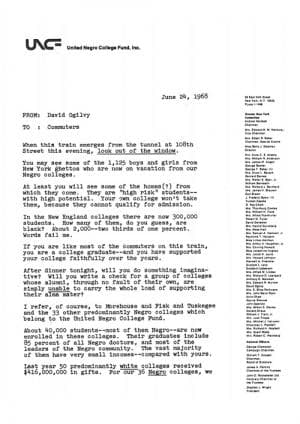David Ogilvy’s letter for the United Negro College Fund, from 1968
Back in 1968, David Ogilvy was appointed as Chair of the United Negro College Fund. He soon realised that he might be able to use his copywriting skills to help the organisation raise funds and wrote a piece that used an unusual delivery mechanism: a train.
- Written by
- Mark Phillips
- Added
- March 10, 2011
On one evening, Ogilvy’s letter was placed on every seat of every train leaving Grand Central Station for the affluent suburbs of New York.
When you read his copy, you’ll see that rather than just present the reader with a series of statistics demonstrating how unfair the US college system was to black students, he actually chose to write about the readers’ journey, both to their home and to their current position in life.
The letter begins:
‘When this train emerges from the tunnel at 108th street this evening, look out of the window.’
As the train burst into daylight, the commuters saw the slums of Harlem. And – as the letter goes on to point out – some of the 1,125 boys and girls who attend ‘our negro colleges’.
Continue reading and you’ll see that the donor remains central to the story throughout the appeal. Ogilvy writes about the support they give their own college and compares it to the many black graduates who simply cannot afford to support their ‘alma mater’. And in doing so he makes a suggestion; he asks the donor to do something imaginative.
Not kind. Not generous. Not selfless.
Something imaginative.
It’s a term that I’ve not seen in a fundraising letter before. But as a means of defining the reader, it’s pretty powerful. That imaginative act is to give a percentage of the amount they give to their own college to the United Negro College Fund. How much? It’s their choice but he does make a couple of suggestions with ten and fifty per cent.
After showing how efficient, fair and important the colleges supported by the UNCF are, he closes by giving a nod to the warm feeling such a gift might generate amongst readers:
‘Please decide now what percentage of your gift to your own college you wish to send to UNCF, and mail it in the envelope I have enclosed. Perhaps you will then sleep a little better during the long hot summer.’
And just in case the reader might not have much freely available cash, he makes a suggestion in the PS that a gift of stock would be equally valuable. His use of underlining is worth a second look too.
In just one night it raised $26,000.
Much of the reason for this success can be summed up in one word – relevance. By focusing on the readers and tying their story to that of the black students, Ogilvy builds a relationship between them. One that gives both groups a real benefit. That’s something that many charities would do well to focus on today.



















